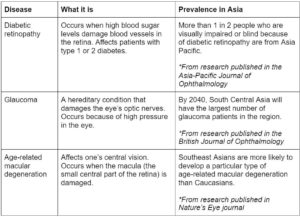Detecting eye diseases is tedious work. Seated in darkened rooms, trained eye graders examine images of retinas on a screen. They look for abnormalities that could indicate diabetic retinopathy—one of the top causes of blindness in Singapore. The job is so strenuous that shifts usually last only 4 hours.
One startup wants to change this. EyRis, a Singapore-based healthtech company, is using artificial intelligence (AI) to detect 3 types of eye diseases: diabetic retinopathy, glaucoma suspect, and age-related macular degeneration.
That is done with its deep learning software Selena+, which can automatically detect these diseases from images of eye retinas. When medical professionals upload a retinal image, the software will compare it against the dataset it has been trained on, which comprises nearly 500,000 retinal images of patients with the 3 diseases. Within just a couple of minutes, it will deliver a diagnosis.
Selena+ was developed by the Singapore Eye Research Institute and National University of Singapore’s School of Computing. “It could potentially reduce 75% of the workload performed by the professional graders, enabling them to re-focus their work on the more sophisticated and complex tasks,” co-founder Dr. Daniel Ting, who’s also an associate consultant at Singapore’s National Eye Centre, told KrASIA.
Some clinics and hospitals in Malaysia, Vietnam, and the Philippines are already using the software, and its footprint is set to increase. Under an agreement with Japan’s Topcon Healthcare Solutions, it will soon be available in 18 Southeast and South Asian countries.

Other organizations are similarly working with deep learning tools to detect eye diseases. American researchers have created a system to predict the risk of diabetic patients to develop retinopathy within 2 years, according to a study published in The Lancet.
Scientists at the New York Eye and Ear Infirmary of Mount Sinai have developed an AI algorithm to detect age-related macular degeneration. The system can diagnose if the patient has the disease and evaluate its severity.
The technology
Some of the images that Selena+ was trained on are from patients who attended the Singapore Integrated Diabetic Retinopathy Program (SiDRP), a screening project of the local polyclinics, says Dr. Ting. Hence the software works mainly with the retinal images of Singaporean Chinese, Malays, and Indians. That doesn’t mean it is not able to detect the condition in non-Asians too.
When tested with datasets from the Latino, African-Caribbean, and Caucasian community, it still could detect cases of moderate to severe diabetic retinography. It’s significant as the pigmentation of the fundus—a part of the inner eye—varies across ethnicity. “The white Caucasian population has lightly pigmented fundus as compared to Asians and Africans,” said Dr. Ting.
What is also critical, is that the AI system is fed with a large amount of data. “It is important to ensure the training datasets consist of representative data and solid ground truth,” said Dr. Ting. “It is equally, if not more important to test the AI system on multiple independent datasets.”
Looking into the future
Dr. Ting points out that Selena+ hasn’t been assessed yet on portable retinal cameras. It is also still waiting for the approval by the US Food and Drug Administration—a certification that assures safety and effectiveness of medical devices.
EyRis is currently developing classifiers for different severity levels of eye diseases, Dr. Ting added. And further on, AI could also be used to detect eye conditions other than diabetic retinopathy, glaucoma suspect, and age-related macular degeneration.
“That said, we may not call those new algorithms Selena+,” said Dr. Ting. A new iteration of the product might be in the works.


